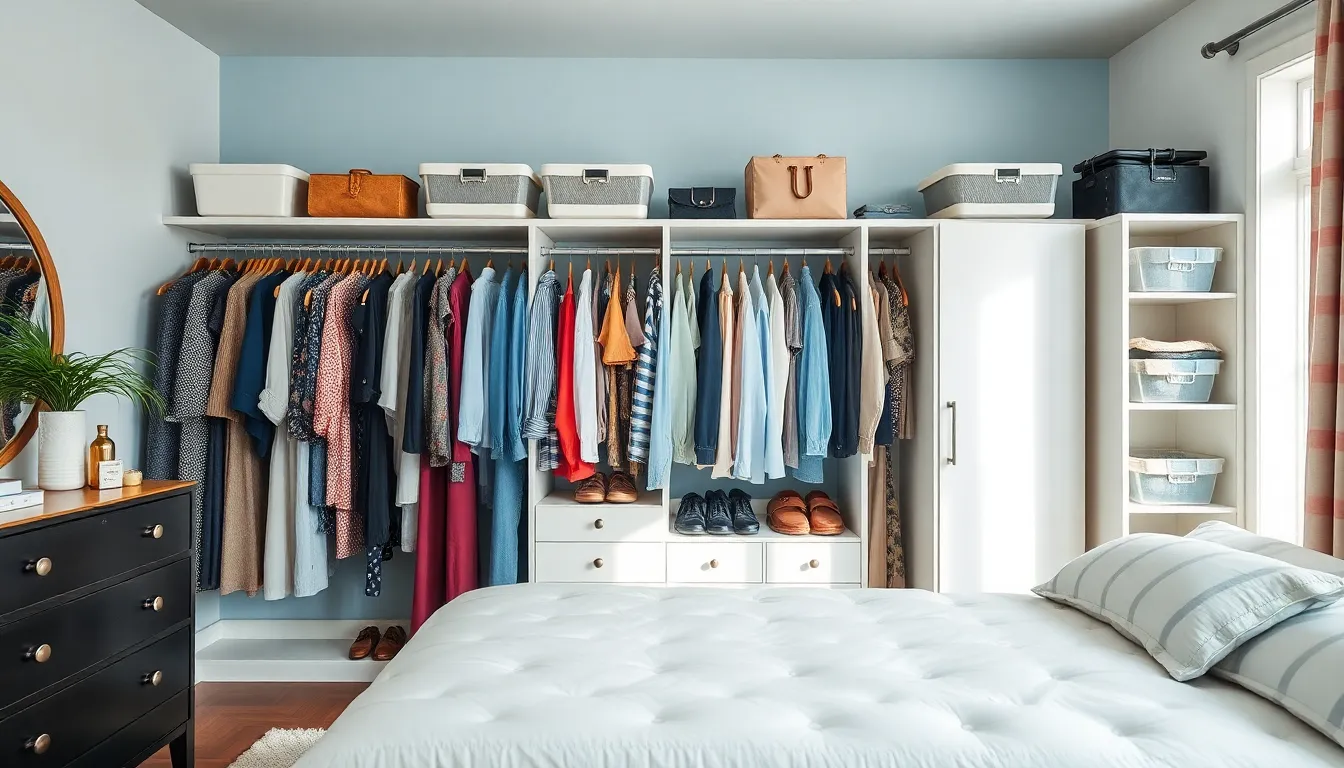Imagine opening your closet and being greeted by a chaotic avalanche of clothes that seem to have staged a rebellion. It’s a scene straight out of a fashion horror movie. Wardrobe organization isn’t just about aesthetics; it’s a game-changer for anyone tired of playing hide-and-seek with their favorite outfits.
Table of Contents
ToggleImportance Of Wardrobe Organization
Effective wardrobe organization improves daily routines. An organized closet simplifies outfit selection, reducing decision fatigue. Accessing clothing becomes quicker and more efficient. It promotes a sense of calm and clarity within personal spaces.
Additionally, a well-organized wardrobe maximizes space. Efficiently utilizing available storage allows for better visibility of items. Visible clothing increases the likelihood of wearing items rather than ignoring them. This habit contributes to a more sustainable fashion approach by encouraging the use of existing pieces.
Furthermore, managing clothing categories promotes mindfulness. Placing similar items together fosters an awareness of style and personal preferences. This awareness often leads to informed shopping choices, preventing unnecessary purchases. Understanding what’s already owned enhances overall wardrobe versatility.
Organization also positively impacts mental well-being. A clutter-free environment reduces stress and anxiety. Many individuals find that tidiness contributes to a productive mindset. Feeling good about one’s wardrobe can enhance overall confidence and self-image.
Regular maintenance of an organized wardrobe proves beneficial. Setting a routine for decluttering encourages ongoing organization. Frequent reassessment makes it easier to adapt to changing fashion needs and lifestyle changes. Keeping only what fits and is worn often leads to a streamlined, enjoyable experience.
Tips For Effective Wardrobe Organization

Organizing a wardrobe involves several key strategies that enhance both functionality and aesthetics. These tips promote ease of access and maintain an orderly space.
Decluttering Your Wardrobe
Begin by evaluating each piece of clothing. If an item hasn’t been worn in over a year, consider letting it go. Every piece should serve a purpose or bring joy. Donate or recycle clothes that don’t fit this criteria. This step creates space for items that are truly wanted and useful. Avoid keeping items based on sentimental value alone, as this can lead to clutter. A minimalistic approach establishes a more enjoyable wardrobe environment.
Categorizing Your Clothes
Organizing clothes into categories streamlines the selection process. Group items such as shirts, pants, and dresses together for easy access. Use subcategories like casual, work, and formal to refine organization further. Color-coding within these categories can enhance visual appeal and simplify outfit pairing. Maintaining a consistent system keeps the wardrobe looking tidy. Each category should reflect personal style and current fashion needs.
Using Storage Solutions
Effective storage solutions maximize space and maintain order. Use shelves, bins, and hangers tailored to different clothing types. Clear bins offer visibility while preventing dust buildup. Utilize vertical space with hooks for accessories or seasonal items. Consider drawer dividers for small articles like socks and underwear. Productive use of storage promotes a streamlined and functional wardrobe. Adapting innovative solutions ensures long-term organization success.
Seasonal Wardrobe Organization
Organizing a wardrobe seasonally enhances both functionality and accessibility. Regular rotation of clothing ensures optimal use of items while maintaining an organized space.
Benefits Of Seasonal Changes
Adapting wardrobes to seasonal changes promotes efficiency and clarity. Seasonal organization reveals unnecessary items, encouraging better decision-making. By rotating clothing, individuals avoid clutter buildup, leading to a more harmonious space. Visibility of seasonal favorites increases, making outfit selection faster. Accessing clothes suited to the current climate enhances comfort and confidence. Sustainable habits flourish as individuals appreciate their existing pieces, reinforcing mindful shopping.
How To Rotate Your Wardrobe
Begin by assessing current clothing collections and evaluating each piece’s relevance. Transition items appropriate for the upcoming season to the front of the closet. Set aside off-season clothing in sealed bins or bags to free up valuable space. Group items by type, such as tops, bottoms, and outerwear, for easy access. Store seasonal accessories alongside corresponding clothing to create cohesive outfits. Regularly review and adjust this organization to maintain optimal efficiency, ensuring readiness for each new season.
Maintaining An Organized Wardrobe
Maintaining an organized wardrobe requires consistent effort and regular evaluations. Establishing a routine is crucial for ensuring long-term organization and ease of access.
Creating A Routine
Creating a routine simplifies the maintenance of wardrobe organization. Setting aside time weekly or monthly for a quick check-up can prevent clutter from accumulating. Individuals can start by putting away any items left out and rotating clothes on display. Staying aware of frequently worn items helps identify what’s essential versus what’s not. Incorporating a habit of cleaning out clothes after each season can keep everything fresh. Reinforcing this practice leads to a more enjoyable experience while dressing each day.
Evaluating Your Wardrobe Regularly
Evaluating your wardrobe regularly enhances wardrobe efficiency. Individuals should review clothes every few months to determine which pieces remain valuable. Noticing items that haven’t been worn in the past six months signals it may be time to let them go. Checking for wear and tear on frequently used pieces can help prioritize repairs. Individuals may consider documenting clothing counts to identify duplicates or rarely used items. This assessment fosters mindful shopping behaviors, encouraging purchases in alignment with one’s current needs and preferences.
A well-organized wardrobe transforms not just the space but the entire experience of getting dressed. By embracing effective organization strategies individuals can cultivate a sense of calm and clarity in their daily routines. This practice not only enhances outfit selection but also promotes mindful shopping and sustainable fashion habits.
Regular maintenance and seasonal adjustments ensure that the wardrobe remains functional and aligned with personal style. With a little effort and commitment anyone can enjoy the benefits of an organized closet that boosts confidence and reduces stress. Investing time in wardrobe organization is a step toward a more streamlined and enjoyable lifestyle.







